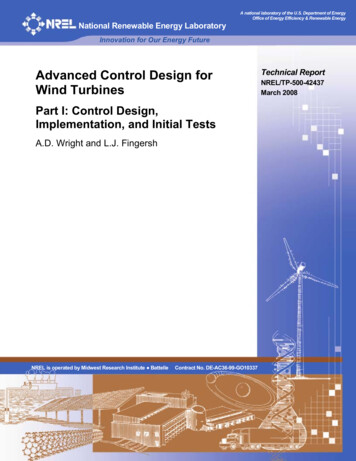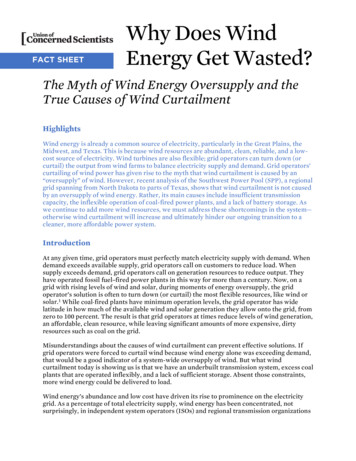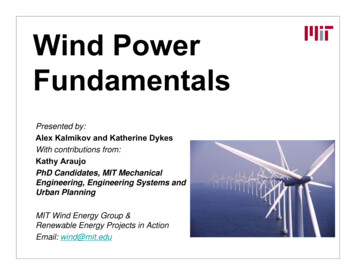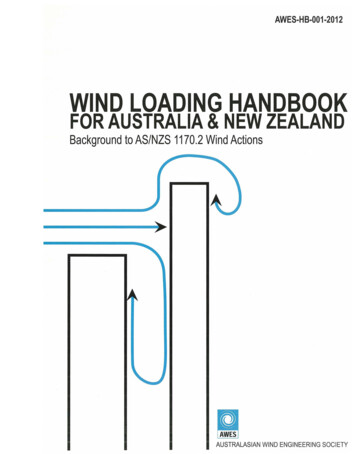
Transcription
A national laboratory of the U.S. Department of EnergyOffice of Energy Efficiency & Renewable EnergyNational Renewable Energy LaboratoryInnovation for Our Energy FutureAdvanced Control Design forWind TurbinesPart I: Control Design,Implementation, and Initial TestsA.D. Wright and L.J. FingershNREL is operated by Midwest Research Institute BattelleContract No. DE-AC36-99-GO10337Technical ReportNREL/TP-500-42437March 2008
Advanced Control Design forWind TurbinesPart I: Control Design,Implementation, and Initial TestsA.D. Wright and L.J. FingershPrepared under Task No. WER8.2101National Renewable Energy Laboratory1617 Cole Boulevard, Golden, Colorado 80401-3393303-275-3000 www.nrel.govOperated for the U.S. Department of EnergyOffice of Energy Efficiency and Renewable Energyby Midwest Research Institute BattelleContract No. DE-AC36-99-GO10337Technical ReportNREL/TP-500-42437March 2008
NOTICEThis report was prepared as an account of work sponsored by an agency of the United States government.Neither the United States government nor any agency thereof, nor any of their employees, makes anywarranty, express or implied, or assumes any legal liability or responsibility for the accuracy, completeness, orusefulness of any information, apparatus, product, or process disclosed, or represents that its use would notinfringe privately owned rights. Reference herein to any specific commercial product, process, or service bytrade name, trademark, manufacturer, or otherwise does not necessarily constitute or imply its endorsement,recommendation, or favoring by the United States government or any agency thereof. The views andopinions of authors expressed herein do not necessarily state or reflect those of the United Statesgovernment or any agency thereof.Available electronically at http://www.osti.gov/bridgeAvailable for a processing fee to U.S. Department of Energyand its contractors, in paper, from:U.S. Department of EnergyOffice of Scientific and Technical InformationP.O. Box 62Oak Ridge, TN 37831-0062phone: 865.576.8401fax: 865.576.5728email: mailto:reports@adonis.osti.govAvailable for sale to the public, in paper, from:U.S. Department of CommerceNational Technical Information Service5285 Port Royal RoadSpringfield, VA 22161phone: 800.553.6847fax: 703.605.6900email: orders@ntis.fedworld.govonline ordering: http://www.ntis.gov/ordering.htmPrinted on paper containing at least 50% wastepaper, including 20% postconsumer waste
SummaryWind turbines are complex, nonlinear, dynamic systems forced by gravity, stochastic winddisturbances, and gravitational, centrifugal, and gyroscopic loads. The aerodynamics of windturbines are nonlinear, unsteady, and complex. Turbine rotors are subjected to a complicated3-D turbulent wind inflow field, which drives fatigue loading.Wind turbine modeling is complex and challenging. Accurate models must contain manydegrees of freedom to capture the most important dynamic effects. Design of controlalgorithms for wind turbines must account for these complexities. These algorithms mustcapture the most important turbine dynamics without being too complex and unwieldy.Typical large commercial wind turbines are variable speed, and control generator torque inRegion 2 to maximize power and control blade pitch in Region 3 to maintain constant turbinepower. Simple classical control design techniques such as proportional-integral-derivative(PID) control for pitch regulation in Region 3 are typically used to design the controls forsuch machines.Classical control design methods are based on a single input and single output. Adisadvantage of classical control methods is that multiple control loops must be used tosimultaneously damp several flexible turbine modes. If these controls are not designed withgreat care, these control loops interfere with each other and cause the turbine to becomeunstable. The potential to destabilize the turbine grows as turbines become larger and moreflexible, and the degree of coupling between flexible modes increases. Using all the availableturbine actuators in a single control loop to maximize load-alleviating potential isadvantageous. Advanced multi-input multi-output (MIMO) multivariable control designmethods, such as those based on state-space models, can be used to meet these multiplecontrol objectives and use all the available actuators and control inputs in a single controlloop.The purpose of this report is to give wind turbine engineers information and examples of thedesign, testing through simulation, field implementation, and field testing of advanced windturbine controls. This report will be Part I in a two-part series of reports that detail advancedcontrol design, implementation, and test results. Part I (this report) will highlight the controldevelopment process, from forming control objectives, to designing the controller, to testingthe controller through analytical simulation, to field implementation and initial field testing.Part II (to be completed later) will give a detailed comparison of results from advanced loadalleviating state-space controllers to test results from baseline controllers without loadalleviation. The purpose of Part II is to demonstrate through rigorous testing the loadmitigating potential of the advanced state-space controllers compared to the baseline control.iii
AcknowledgmentsThe authors would like to thank Dr. Michael Robinson of the National Renewable EnergyLaboratory for his management support and the managers at the U.S. Department of Energyfor project funding and support. In addition, Dr. Karl Stol of the University of Aucklandprovided many valuable suggestions and contributions in state-space control modeling andtesting. Dr. Kathryn Johnson of the Colorado School of Mines provided invaluablesuggestions and guidance in the implementation and testing of these advanced controls in theControls Advanced Research Turbine. The authors would like to thank Dr. Maureen Handfor her work in developing the interface between Simulink and the FAST simulation code.We thank Dr. Jason Jonkman for his valuable suggestions in preparing the description of thebaseline controller designs for this report.Finally, but not least, the authors would like to thank Garth Johnson and Scott Wilde of theNational Renewable Energy Laboratory for their invaluable technician support inmaintaining the Controls Advanced Research Turbine so that this testing could be performed.iv
Common SymbolsA -state matrix,A -state matrix augmented with disturbance statesAa -state matrix in actuator dynamics modelA c -state matrix calculated in control synthesis routineA d -discrete time version of AB -control input matrixB -control input gain matrix augmented with disturbance inputBa -control input gain matrix in actuator dynamics modelB c -control input gain matrix calculated in control synthesis routineBd -wind input disturbance matrixB d -discrete time version of BC -output state matrixC -relates plant output to plant and disturbance statesCa -relates plant output to states in actuator dynamics modelC c -C matrix calculated in control synthesis routineC d -discrete time version of CCont ( s ) -controller transfer functionC p -power coefficientC pmax -maximum power coefficientCt -tower damping coefficient associated with first fore-aft modev
D -control input transmission matrixD c -D matrix calculated in control synthesis routineD d -discrete time version of DDd -wind input disturbance transmission matrixDd c - Dd matrix calculated in control synthesis routineE -set of eigenvalues of closed-loop systemF -state matrix for disturbance state equationFilt ( s ) -filter transfer functionFt -pitch control input gain corresponding to first tower fore-aft modeG -gain in full state feedback lawGd -gain in full state feedback law associated with disturbance stateI gen -generator mass moment of inertia relative to high-speed shaftIrot-total rotational moment of inertia due to rotor, gear-box, shafts, generator, etc.J -quadratic cost functionK -state estimator gain matrixK d -disturbance state estimator gain matrixk -gain multiplying Ω 2 in Region 2 generator torque expressionK D -classical controller derivative gainK p -classical controller proportional gainK i -classical controller integral gainK t -tower stiffness coefficient associated with first fore-aft modevi
M t -tower mass coefficient associated with first fore-aft modem -powerlaw wind-shear coefficientN -dimension of state matrix AN gear -gearbox ratioP -Solution of Ricatti EquationP( s ) -plant transfer functionQ -symmetric, positive semidefinite weighting on the states xQaero -aerodynamic torqueQgen -generator torqueQ1 -generator torque at beginning of Region 2½Q2 -generator torque at end of Region 2½Qrated -rated generator torqueR -symmetric, positive definite weighting on the input uR -Rotor radiuss -Laplace variablet -timeTc ( s ) -Closed-loop transfer Functionu -control inputu op -equilibrium value of control inputΔu -control input perturbationΔua - input to actuator dynamics modelvii
ud -disturbance state-space model outputud op -equilibrium value of disturbance state-space model outputΔud -disturbance state-space model output perturbationΔuˆd -estimated disturbance state-space model output perturbationw -wind disturbance (uniform over rotor disk)Δw -wind disturbance (uniform over rotor disk) perturbationw0 -wind speed at control design point (uniform over rotor disk)x -state vectorx op -equilibrium value of state vectorΔ x -state vector perturbationΔ x a - actuator linear model state vectorΔ x̂ -estimated state vector perturbationx& -time derivative of xx& op -equilibrium value of time derivative of xΔ x& -time derivative of x perturbationΔ x̂& -time derivative of estimated x perturbationy -control (or measured) outputy op -equilibrium value of control (or measured) outputΔ y -control (or measured) output perturbationΔya - output of actuator dynamics modelviii
Δ ŷ -estimated control (or measured) output perturbationzd -disturbance stateΔ zd -perturbed disturbance stateΔ zˆd -estimated perturbed disturbance stateΔ z&d -time derivative of perturbed disturbance stateΔ z&ˆd -time derivative of estimated perturbed disturbance stateα -partial derivative of rotor aerodynamic torque with respect to wind speedδ - damping ratioγ -partial derivative of rotor aerodynamic torque with respect to rotor speedλ -Tip-speed ratioλopt -Optimum value of tip-speed ratio corresponding to C pmaxθ -blade pitchΔθ -blade pitch perturbationθ 0 -blade pitch at control design point (equilibrium)θ& -blade pitch rateΔθ& -blade pitch rate perturbationθ&c -commanded blade pitch rateΔθ&com -commanded blade pitch rate perturbationΘ -matrix relating the disturbance model output to the disturbance statesρ -air densityΩ -turbine rotational speedix
Ω1 -turbine rotational speed at beginning of region 2½Ω 2 -turbine rotational speed at end of region 2½ΔΩ -turbine rotational speed perturbation& -derivative of turbine rotational speed perturbationΔΩ ΔΩ dt -integral of turbine rotational speed perturbationΩ 0 -value of rotor speed at control design pointω -undamped natural frequencyωd -damped natural frequencyζ-partial derivative of rotor aerodynamic torque with respect to rotor collective pitchx
ContentsSummary. iiiAcknowledgments. ivCommon Symbols.vContents . xiTables. xiiiFigures. xiii1.Introduction.11.0 Report Purpose.11.1 Wind Turbine Control Challenges .11.2 Control Objectives .11.3 Typical Industry Controllers .42.Control Design and Simulation Tools .72.0 Introduction.72.1 Control Development Process.72.2 Variable-Speed Turbine Operating Regions.72.3 Establish Control Objectives.92.4 Determine Simplified Dynamic Model.102.4.1 Linear Model.102.4.2 Issues in Wind Turbine Model Linearization .122.5 Apply Control Synthesis Tools.132.6 Perform Dynamic Simulations.163. Controls Advanced Research Turbine Baseline Control Design Examples .193.0 Goals and Contents .193.1 Description of the Controls Advanced Research Turbine .193.2 Controls Advanced Research Turbine Generator Torque Design Example .203.3 Controls Advanced Research Turbine Region 3 Baseline Pitch Control Design .273.3.1 Basic Control Design .273.3.2 Gain Scheduling.323.3.3 Anti-Windup .363.3.4 Filtering the Generator or Rotor Speed Measurement.383.3.5 Active Tower Damping Control .394.Illustrating State-Space Control Design Steps and Tools .434.0 Goals and Contents .434.1 Region 3 Collective Pitch Control Design Example.434.1.1 Control objectives .434.1.2 FAST linearization.444.1.3 Control design synthesis .464.1.4 State estimation realizable controller.484.1.5 Model Simulation with the State Estimator Controller.504.2 Region 3 Generator Torque Damping Control Design Example.524.2.1 Control objectives .534.2.2 Linear model description .534.2.3 FAST linearization.544.2.4 Control design.54xi
4.2.5 Control simulation .564.3 Independent Blade Pitch Control .584.3.1 Control objectives .594.3.2 Linear model description .594.3.3 FAST linearization.604.3.4 Control design.614.3.5 Control simulation .635.Implementing and Testing a Region 3 Rotor Collective Pitch Controller for theControls Advanced Research Turbine .665.0 Introduction.665.1 Control Design and Implementation.665.1.1 Actuator model.665.1.2 Linear model .675.2 Simulation Tests.705.3 Further Implementation Issues.725.4 Field Test Results and Comparisons.745.5 Further Test Results .765.6 Lessons Learned.786. Using Generator Torque Control to Design, Implement, and Test a Region 2and Region 3 Drive Train Damper.796.0 Introduction.796.1 Control Objectives and Structure.796.2 State-Space Control Design .796.2.1 Generator torque control design.806.2.2 Region 2 to 3 generator torque control transition .816.2.3 Region 3 pitch controller .826.3 Simulation Tests.826.4 Implementation Issues .846.5 Field Test Results and Comparisons.886.6 Lessons Learned.927. Conclusions and Future Work .93References.96Appendix A: Input Files for Simulation and Linearization .A1Appendix B. MATLAB Control Design Scripts.B1Appendix C. Simulating Control with Fortran Subroutines Linked with FAST .C1xii
List of TablesTable 3.1:Table 3.2:Table 3.3:Table 4.1:Table 4.2:Table 4.3:Table 5.1:Table 6.1:Table 6.2:CART Parameter Values.22FAST Variable-Speed Generator Model Inputs .24CART Tower Parameter Values .40States Contained in the Linear Model for Collective Pitch Control Design.43States Contained in the Linear Model for Generator Torque Control Design .54States Contained in the Linear Model for Independent Pitch Control Design .60Comparison between Baseline PI and FAST State-Space Controller .74Preliminary Comparison of Baseline and FAST State-Space Controllersfor Region 2 Operation .88Comparison of Baseline and FAST State-Space Controller forRegion 3 Operation.90List of FiguresFigure 1.1:Figure 1.2:Figure 1.3:Figure 2.1:Figure 2.2:Figure 2.3:Figure 2.4:Figure 3.1:Figure 3.2:Figure 3.3:Figure 3.4:Figure 3.5:Figure 3.6:Figure 3.7:Figure 3.8:Figure 3.9:Figure 3.10:Figure 3.11:Figure 3.12:Figure 3.13:Figure 3.14:Figure 3.15:Figure 3.16:Figure 3.17:Figure 3.18:Figure 4.1:Figure 4.2:Figure 4.3:Wind turbine operating regions .2Typical plot of power coefficient versus TSR .3Typical industry controller.4Variable-speed turbine operating regions .8Variation of control input gains with pitch angle .12State estimator control diagram .15FAST wind turbine block.18The CART.19Variable-speed turbine operating regions .20Cp versus TSR and pitch for the CART .21Details of Region 2½ .23FAST simulation results (red) using the simple VS model compared toresults in Figure 3.2 (blue) .25Simulink model of the generator torque controller.26Simulink model of the pitch controller .31Response to a step wind input for various values of δ .32Performance at different operating points.33Variation of control input gains with pitch angle .34Simulink model of the pitch controller .35Performance at different operating points.36Use of anti-windup in preventing rotor overspeed .37Simulink pitch control model with anti-windup .37Simulink pitch control model with filtered speed.38Filter transfer function bode plot .39Simulink controller model with tower feedback.41Simulated tower bending moment in response to step wind input forvarious values of G .42Rotor aerodynamic torque versus blade pitch angle for variouswind-speeds.45Simulink model of the realizable Region 3 pitch controller .49Simulated rotor speed with the DAC controller .51xiii
Figure 4.4: Simulated HSS torque.52Figure 4.5: Simulink model of controller-turbine FAST System, showingdrive-damper realizable controller.56Figure 4.6: Regulated speed of the closed-loop system .57Figure 4.7: Simulated HSS torque excited by turbulence .58Figure 4.8: Simulated generator torque for the turbulence case.58Figure 4.9: Simulink model of controller-turbine FAST System, showingindependent pitch realizable controller.63Figure 4.10: Simulated Region 3 rotor-speed using independent pitch controller.64Figure 4.11: Simulated blade-tip flap deflection excited with step wind inputs .64Figure 5.1: FAST simulated generator speed excited by step winds .71Figure 5.2: FAST simulated generator speed excited by turbulent winds .71Figure 5.3: Simulink model of the realizable controller with actuator model.72Figure 5.4: Measured hub-height wind speed during the PI control case andthe FAST control case.74Figure 5.5: Measured LSS rotational speed during CART operation using thePI controller and the FAST controller .75Figure 5.6: Measured LSS torque during CART operation using the PI controllerand the FAST controller.75Figure 5.7: Measured pitch rates during CART operation using the PI controllerand the FAST controller.76Figure 5.8: Measured pitch rates and LSS torque during CART operation usingthe state-space controller.77Figure 5.9: Measured pitch rates and blade pitch during CART operation usingthe state-space controller.77Figure 6.1: Simulink model of the realizable controller.83Figure 6.2: FAST-simulated generator speed for the baseline and state-spacecontrollers excited by step winds spanning Regions 2 and 3.84Figure 6.3: Measured generator torque showing stable and unstable behaviorduring startup for two implemented controllers.85Figure 6.4: Measured CART data during transition from Region 2 to Region 3.86Figure 6.5: Measured CART data during operation in Region 3, showinggenerator pitch interaction in first controller .87Figure 6.6: Measured CART data for Region 2 control for the baseline andstate-space case .89Figure 6.7: Power spectral density of LSS and generator torque for the Region 2baseline and state-space cases.90Figure 6.8: Measured CART data for Region 3 control for the baseline andstate-space case .91Figure 6.9: Power spectral density of LSS and generator torque for the Region 3baseline and state-space cases.91Figure C.1. Simulated rotor speed during PI control simulating with the control subroutineand the Simulink control model.C-2xiv
1. Introduction1.0 Report PurposeThe purpose of this report is to give wind turbine engineers information about designing,implementing, and testing advanced control systems for wind turbines. We want toillustrate use of available control design tools as well as the steps involved in de
1617 Cole Boulevard, Golden, Colorado 80401-3393 303-275-3000 www.nrel.gov . Operated for the U.S. Department of Energy Office of Energy Efficiency and Renewable Energy by Midwest Research Institute Battelle . Contract No. DE-AC36-99-GO10337. Technical Report . NREL/TP-500-42437 . March 2008 . Advanced Control Design for Wind Turbines











